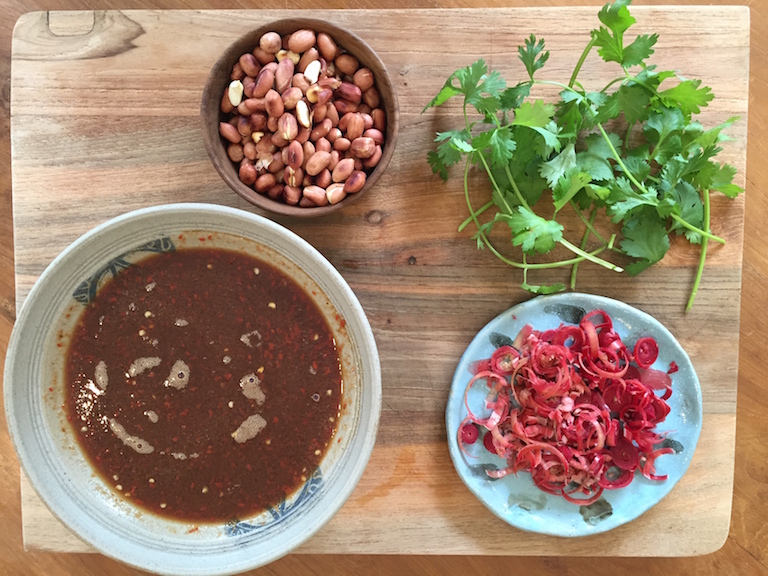How to make our Javanese-style Rujak
Have you eaten Rujak? In simple terms, this dish is a spicy salad predominantly made with fresh fruit that is sweet, crunchy and cold.
Rujak is most often eaten during the *siang hours of the day, when the day is at its hottest. This spicy dish consists mostly of fruit (and some vegetables) and can be eaten as a snack in its own right, or occasionally as an accompaniment to a meal. Served with a dressing that includes all four basic tastes - sweet (manis), sour (asam), salty (asin) and bitter (pahit), Rujak is sold in restaurants, *warungs and most commonly by *kaki limas in Jakarta and in greater Indonesia.
Rujak Buah purchased from our local kaki lima
However, Rujak is not exclusive to Indonesia. Varieties of Rujak can also be found widely throughout Malaysia and Singapore (where it is called, ‘Rojak’). As with Indonesian Rujak, the recipe varies according to location and availability of ingredients. For instance, Rujak prepared in places close to the sea often includes seafood such as cuttlefish, prawns, sea cucumber or octopus. The Balinese version of Rujak, ‘Rujak Kuah Pindang’, consists of a variety of tropical fruits; but instead of being dressed with the normal spicy sauce, the fruits are soaked in a spicy fish broth.
The stunning Bunga Kecombrang. Perhaps you better know it as Torch Ginger flower
The Rujak that we are going to prepare today is a simple traditional Javanese recipe with the addition of a special ingredient, Bunga Kecombrang. More commonly known as the Torch Ginger flower, Kecombrang can be found shooting straight up from the ground in many tropical gardens and as its common name suggests, it is a member of the Ginger family. The bud of the waxy Kecombrang flower adds a sweet, flowery and piquant flavour to a dish and has the added benefit of being high in antioxidants and as well as possessing antibacterial properties.
When shredded, the Kecombrang bud behaves like a spice in salads and can be added to sauces and dips. Kecombrang can also mask strong fish flavours and is often added to fish curries, especially in *Nyonya cuisine. Most commonly, Kecombrang can be found in cuisine from Thailand, Malaysia, Singapore, and Indonesia, where the plant grows.
In Jakarta, Bunga Kecombrang can be purchased at your local pasar, better quality supermarkets (like Grand Lucky) and also at your local florist. On a weekly basis I drop in to see Pak Agus and Pak Mardi at my local *toko bunga and pick up four stems. I then put them in a vase; ready to enhance my cooking when required ( - In the meantime, they make a pretty display in my living room).
How to make Rujak - ajb Style
Ingredients
Salad
Mangga Muda (green mango)
Jeruk Bali (Asian pomelo)
Jambu Air (rose appe)
Nanas (pineapple)
Bengkuang (jicama)
Delima (pomegranate)
Timun (cucumber)
Other suggested fruit: starfruit (belimbing), ambarella (kedondong), papaya (pepaya), guava (jambu biji), raw sweet potato (ubi).
Dressing
50g palm sugar (grated)
50g coconut sugar
2 medium chillis sliced finely (seeds removed if you don’t like too much heat)
1/4 tsp shrimp paste
30g tamarind paste
4 Tb hot water
1Tb lime juice (jeruk nipis)
Kecombrang (Torch Ginger flower) - finely sliced
Some of the ingredients for the sauce and garnish including (from clockwise): bunga kecombrang, toasted peanuts, coconut sugar (bowl) and palm sugar (solid), chilli, jeruk nipis (local lime) and shrimp paste (centre)
Garnish
Toasted peanuts
Mint
Method
1. Cut all salad ingredients into bit-sized chunks. Cover and place in refrigerator
2. To prepare the dressing, place tamarind paste in a heat-proof jug and add the hot water, stirring until dissolved
3. Strain the tamarind solution to remove seeds and place liquid in small bowl
4. In a food processor or using a traditional mortar and pestle (cobek ulek ulek) grind the sliced chills, sugars, shrimp paste and lime juice until smooth
5. Add the tamarind liquid to the paste and mix until well blended
6. Set aside to cool
To prepare the salad
7. Remove salad ingredients from the fridge
8. Place most of the sliced kecombrang into the dressing and stir
9. Pour dressing into salad and mix until evenly distributed
10. Arrange salad onto serving plate/dish and garnish with remaining kecombrang, toasted peanuts and small sprigs of mint if you wish
Selamat Makan Semua! Enjoy your meal everyone! (The addition of coriander as a garnish is our twist on the recipe. Another tasty alternative would be mint leaves)
Other types of Rujak you might like to try..
Rujak Bebek (also known as Rujak Tumbuk) - The ingredients for Rujak Bebek are very similar to those of Rujak Buah (Fruit Rujak), however, in this case the fruits and the sauce are combined and then mashed together using a traditional mortar and pestle. No additional sauce is added.
Rujak Juhi - This Rujak is served with salted cuttlefish, fried tofu stuffed with fish, fried boiled potatoes, cucumber, noodles, lettuce, cabbage, peanut sauce, vinegar, chilli and fried garlic. Rujak Juhi was introduced to Jakarta by the original Chinese community of Batavia.
Rujak u Groeh - Originating in the Aceh provence of North Sumatra, Rujak u Groeh is made of very young coconut meat, green papaya, birds eye chilli, palm sugar, ice and salt - all finished off with a dash of lime.
Asinan Buah - A version of the traditional Rujak Buah more commonly found in West Java (we enjoyed it in Depok, West Jakarta). Asinan Buah consists of a variety of tropical fruits that have been soaked in a salty, spicy soup. Best eaten cold.
My driver loves Asinan Buah. His favourite recipe is prepared by a vendor in Depok, South Jakarta
*Siang - the hours between 11am - 3pm (but this is dependent upon who you ask!)
*Warung - local cafe
*Kaki lima - traditional food cart
*Toko bunga - flower shop
*Nyonya cuisine - is the term used to describe cuisine by the Peranakans who were descendants of early Chinese migrants. They settled in Penang, Malacca, Singapore and Indonesia and intermarried with local Malays. Nyonya cuisine is a combination of Chinese, Malay and other influences.
Did you enjoy this recipe? We certainly hope you did. If you would like more recipes that feature easily available local ingredients, why not try any (or all!) of the following:
Jeruk Bali Salad
Asian- Inspired Noodle Salad
Soto Ayam
Red Curry Coconut Prawns
What is Jamu and how to make your own
Words: Jo Stevens Photography: a journey bespoke
















